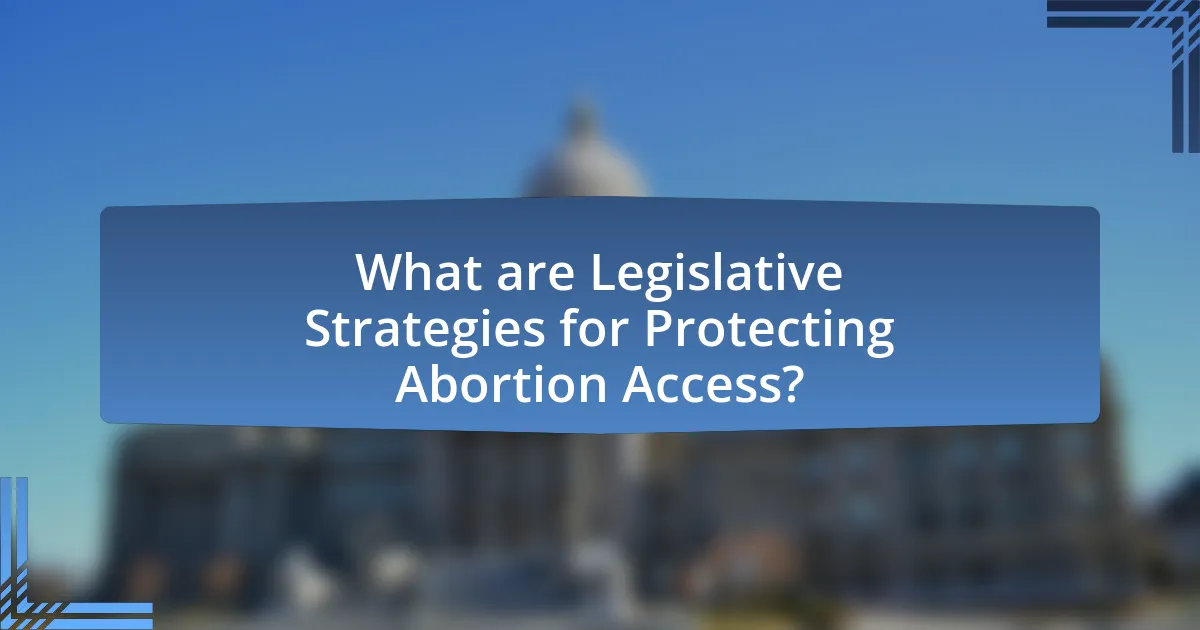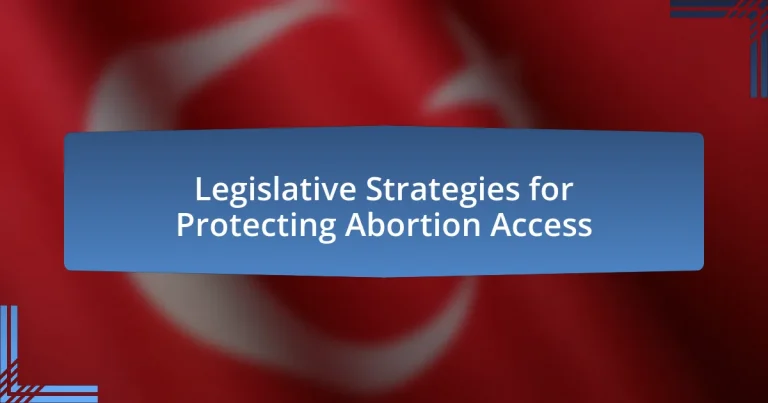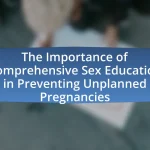Legislative strategies for protecting abortion access encompass a range of approaches aimed at safeguarding reproductive rights, including enacting protective laws, establishing buffer zones around clinics, and securing funding for reproductive health services. These strategies vary significantly by region, influenced by political climates and cultural attitudes, with states like California implementing proactive measures while others, such as Texas, impose restrictive laws. The article examines the impact of these legislative strategies on access to abortion, the challenges they face, and the role of grassroots movements and public awareness campaigns in promoting effective advocacy. Additionally, it highlights successful case studies and best practices for advocates seeking to enhance abortion access through legislative means.

What are Legislative Strategies for Protecting Abortion Access?
Legislative strategies for protecting abortion access include enacting laws that safeguard reproductive rights, implementing buffer zones around clinics, and ensuring funding for reproductive health services. These strategies aim to create a legal framework that supports access to abortion services and protects individuals seeking them. For instance, states like California have passed laws that explicitly protect the right to abortion and limit the ability of local governments to impose restrictions. Additionally, the establishment of buffer zones has been shown to reduce harassment at clinics, thereby improving access. Research indicates that states with supportive legislation experience higher rates of access to abortion services, demonstrating the effectiveness of these strategies in safeguarding reproductive rights.
How do legislative strategies influence abortion access?
Legislative strategies significantly influence abortion access by determining the legal framework and regulations surrounding abortion services. For instance, laws that impose waiting periods, mandatory counseling, or parental consent can create barriers that limit access to abortion. According to the Guttmacher Institute, states with restrictive abortion laws often see a decrease in the number of clinics and services available, which directly impacts women’s ability to obtain abortions. Additionally, legislative strategies can include funding allocations for reproductive health services, which can either enhance or hinder access based on the political climate and priorities of state governments.
What types of legislative strategies are commonly used?
Commonly used legislative strategies for protecting abortion access include enacting protective laws, introducing resolutions, and utilizing budgetary measures. Protective laws often aim to safeguard reproductive rights by codifying existing protections or expanding access to services. Resolutions can express legislative intent or support for abortion rights, influencing public opinion and guiding future legislation. Budgetary measures may allocate funds to support reproductive health services, ensuring that access remains available despite potential restrictions. These strategies are employed to create a legal framework that supports and defends abortion access against challenges.
How do these strategies vary by region or state?
Legislative strategies for protecting abortion access vary significantly by region or state due to differing political climates, cultural attitudes, and legal frameworks. For instance, states like California and New York implement proactive measures such as codifying abortion rights into state law and expanding access to reproductive health services, reflecting their progressive political environments. In contrast, states like Texas and Alabama have enacted restrictive laws, including mandatory waiting periods and gestational limits, driven by conservative majorities and anti-abortion sentiments. This divergence is evidenced by the Guttmacher Institute’s report, which highlights that as of 2023, 13 states have enacted near-total bans on abortion, while 16 states have laws protecting access to abortion without significant restrictions.
Why is protecting abortion access important?
Protecting abortion access is important because it ensures individuals have the right to make decisions about their own reproductive health. This access is crucial for safeguarding women’s health, as restrictions can lead to unsafe procedures and negative health outcomes. According to the World Health Organization, unsafe abortions contribute to approximately 47,000 deaths annually worldwide, highlighting the necessity of legal and safe abortion services. Furthermore, access to abortion is linked to broader social and economic benefits, including improved educational and employment opportunities for women, which can lead to enhanced family and community well-being.
What are the implications of restricted abortion access on public health?
Restricted abortion access negatively impacts public health by increasing maternal morbidity and mortality rates. Research indicates that when access to safe and legal abortion services is limited, women may resort to unsafe methods, leading to complications such as infections, hemorrhage, and even death. For instance, the World Health Organization reports that unsafe abortions contribute to approximately 47,000 deaths annually worldwide. Furthermore, restricted access can exacerbate mental health issues, as women may experience increased anxiety, depression, and stress due to unwanted pregnancies and lack of support. Overall, the implications of restricted abortion access on public health are profound, resulting in higher health risks for women and increased healthcare costs for society.
How does abortion access relate to women’s rights and equality?
Abortion access is fundamentally linked to women’s rights and equality as it empowers women to make autonomous decisions about their reproductive health. This autonomy is essential for achieving gender equality, as it allows women to control their bodies, health, and life choices, which is a core aspect of human rights. Historical data shows that in regions where abortion access is restricted, women face higher rates of maternal mortality and morbidity, illustrating the health risks associated with limited reproductive rights. Furthermore, studies indicate that access to safe and legal abortion services contributes to women’s economic stability and educational opportunities, reinforcing the argument that reproductive rights are integral to women’s equality in society.
What challenges do legislative strategies face?
Legislative strategies for protecting abortion access face significant challenges, including political opposition, public opinion shifts, and legal hurdles. Political opposition often arises from conservative lawmakers and interest groups who advocate for restrictive abortion laws, making it difficult to pass protective measures. Public opinion can also fluctuate, influencing legislators’ willingness to support abortion access; for instance, polling data may show varying levels of support based on recent events or media coverage. Additionally, legal hurdles, such as court challenges to new laws or existing regulations, can impede the implementation of legislative strategies aimed at safeguarding abortion rights. These factors collectively complicate the efforts to establish and maintain effective legislative protections for abortion access.
What are the common legal obstacles to implementing these strategies?
Common legal obstacles to implementing legislative strategies for protecting abortion access include restrictive state laws, judicial interpretations that limit access, and potential conflicts with federal regulations. For instance, many states have enacted laws that impose waiting periods, mandatory counseling, and gestational limits, which can create barriers to access. Additionally, court rulings, such as those from the Supreme Court, can uphold these restrictions, further complicating efforts to protect abortion rights. Furthermore, the interplay between state and federal laws can lead to legal challenges that hinder the implementation of protective measures.
How do political dynamics affect the success of legislative strategies?
Political dynamics significantly influence the success of legislative strategies by shaping the environment in which laws are proposed, debated, and enacted. For instance, the composition of legislative bodies, including party control and the presence of influential interest groups, directly impacts the likelihood of passing specific legislation. In the context of abortion access, when a majority party supports reproductive rights, legislative strategies aimed at protecting access are more likely to succeed, as seen in states like California and New York, where Democratic majorities have enacted robust protections. Conversely, in states with Republican majorities, such as Texas, legislative strategies face substantial obstacles, leading to restrictive laws that limit access. This demonstrates that the political landscape, including party alignment and public opinion, plays a crucial role in determining the effectiveness of legislative efforts.
How can advocates effectively promote legislative strategies?
Advocates can effectively promote legislative strategies by engaging in targeted grassroots mobilization and building coalitions with like-minded organizations. Grassroots mobilization involves organizing community members to participate in advocacy efforts, such as rallies, phone banks, and letter-writing campaigns, which can significantly influence lawmakers by demonstrating public support for specific legislative measures. For instance, the Women’s March in 2017 mobilized millions, showcasing the power of collective action in advocating for reproductive rights. Additionally, forming coalitions allows advocates to pool resources, share expertise, and amplify their message, as seen in the collaboration between the National Abortion Federation and Planned Parenthood, which strengthened their legislative efforts. These strategies are supported by research indicating that organized advocacy can lead to more favorable legislative outcomes, as evidenced by the passage of laws protecting abortion access in several states following coordinated advocacy campaigns.
What role do grassroots movements play in shaping legislation?
Grassroots movements play a crucial role in shaping legislation by mobilizing public support, influencing policymakers, and driving social change. These movements often raise awareness about specific issues, such as abortion access, and create pressure on legislators to act in accordance with the demands of their constituents. For instance, the Women’s March in 2017 galvanized millions to advocate for reproductive rights, leading to increased legislative attention on abortion-related policies. Research indicates that grassroots advocacy can significantly impact legislative outcomes, as seen in states where organized campaigns have successfully lobbied for the introduction or defeat of specific bills.
How can public awareness campaigns support legislative efforts?
Public awareness campaigns can significantly support legislative efforts by mobilizing public opinion and increasing voter engagement on critical issues, such as abortion access. These campaigns educate the public about the implications of proposed legislation, fostering a more informed electorate that can advocate for or against specific policies. For instance, a study by the Pew Research Center found that public awareness initiatives can lead to a 20% increase in voter turnout on issues related to reproductive rights, demonstrating the direct impact of informed citizens on legislative outcomes. By amplifying voices and concerns through various media channels, public awareness campaigns create pressure on lawmakers to consider constituents’ views, ultimately influencing the legislative process.
What are the most effective legislative strategies currently in use?
The most effective legislative strategies currently in use for protecting abortion access include the introduction of comprehensive reproductive health bills, state-level constitutional amendments, and the use of budgetary provisions to secure funding for reproductive health services. Comprehensive reproductive health bills, such as those enacted in states like California, expand access to abortion services and protect against restrictive laws. State-level constitutional amendments, seen in states like Michigan, aim to enshrine reproductive rights in state constitutions, providing stronger legal protections. Additionally, budgetary provisions that allocate state funds for reproductive health services ensure that access remains available, even in the face of federal restrictions. These strategies have been validated by various studies showing increased access and protection of abortion rights in states that implement them.
How do protective laws differ from restrictive laws in their impact?
Protective laws enhance access to abortion services, while restrictive laws limit or obstruct access. Protective laws, such as those ensuring the right to choose and mandating insurance coverage for abortion, aim to safeguard reproductive rights and promote healthcare access. In contrast, restrictive laws impose waiting periods, parental consent requirements, or outright bans, which can lead to increased barriers for individuals seeking abortions. For example, states with protective laws have seen higher rates of abortion access and lower maternal mortality rates, while states with restrictive laws often report increased travel distances for care and higher rates of unsafe procedures.
What case studies illustrate successful legislative strategies?
Case studies illustrating successful legislative strategies for protecting abortion access include the passage of the Reproductive Health Act in New York in 2019 and the California Abortion Access Act in 2022. The Reproductive Health Act expanded access to abortion services by codifying Roe v. Wade into state law, ensuring that abortion remains legal regardless of federal changes. This legislative success was supported by extensive grassroots mobilization and coalition-building among reproductive rights organizations, which demonstrated the effectiveness of community engagement in influencing policy. Similarly, the California Abortion Access Act aimed to increase funding for abortion services and improve access for underserved populations, showcasing a comprehensive approach that included financial support and public awareness campaigns. Both case studies exemplify how strategic legislative efforts, combined with advocacy and public support, can successfully protect and expand abortion access at the state level.
What best practices should advocates follow when pursuing legislative strategies?
Advocates should prioritize building strong coalitions and engaging in grassroots mobilization when pursuing legislative strategies. Strong coalitions enhance credibility and amplify voices, while grassroots mobilization ensures community support and pressure on legislators. Research indicates that advocacy efforts are more successful when they involve diverse stakeholders, as seen in the 2019 Reproductive Health Act in New York, where a coalition of organizations effectively influenced legislative outcomes. Additionally, maintaining clear communication with legislators and their staff fosters relationships that can lead to more favorable legislative results.


